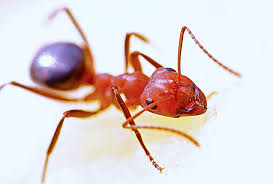First aid for fire ant stings

Fire ant stings are painful with a burning or itching sensation
- Fire ants usually sting all at once and can sting repeatedly.
- Stings are painful, with burning or itching that can last up to an hour.
- If you’ve been stung, apply a cold compress to relieve swelling and pain, and wash skin with soap and water.
- Immediately seek medical attention if you are allergic to insect stings or have symptoms of allergy.
Red Imported Fire Ants are not considered an established species in Western Australia. However, there has been a recent detection on a tenant property at Fremantle ports.
For more information, contact the Department of Primary Industries and Regional Development’s Pest and Disease Information Service (PaDIS) on (08) 9368 3080.
What are the symptoms of fire ant stings?
Fire ant stings are painful, and can cause:
- a severe burning sensation
- "fiery" pain
- swelling
- redness
- blistering.
Stings can last up to an hour.
Small blisters or pustules (small bumps with fluid or pus), can appear on the skin after a couple of hours and sometimes even up to a day or two after being stung.
If the blisters get broken they can become infected.
What should you do if you've been stung by fire ants?
If the ants are still on you or your pet pick them off by hand. If you try and brush them off this will make them more aggressive, and if ants are sprayed with water, they may latch on with their jaws.
- Apply a cold compress to alleviate swelling and pain.
- Carefully wash the affected area with soap and water.
- Immediately seek medical attention if you are allergic to insect stings or have symptoms of allergy.
Fire ant stings can take up to 10 days to heal. If the blisters or pustules break, there is a risk they can get infected. If pain persists or blisters get infected, see your doctor. Infected stings may require antibiotics.
Severe allergic reactions
Although rare, fire ant stings can cause severe and sometimes fatal allergic reactions (e.g. anaphylaxis).
Seek immediate medical advice if you are allergic to insects or have the following symptoms:
- rapid onset of flushing
- general hives
- swelling of the face, eyes or throat
- chest pains
- nausea
- severe sweating
- breathing difficulties
- faintness.
How can you prevent fire ant stings?
- Move away from the area where the fire ants are located.
- Watch our for fire ant nests when you mow the lawn or work in a garden.
- Wear gloves when gardening, and protective clothing like thick socks and boots whilst working or walking outdoors.
Who is more at risk of fire ant stings?
Young children and pets are more likely to get fire ant stings because they are less aware of fire ant nests.
Dogs and other pets may also get fire ants on their fur and then bring them in the house putting owners at risk from attacks.
Where to get help
Acknowledgements
Environmental Health
This publication is provided for education and information purposes only. It is not a substitute for professional medical care. Information about a therapy, service, product or treatment does not imply endorsement and is not intended to replace advice from your healthcare professional. Readers should note that over time currency and completeness of the information may change. All users should seek advice from a qualified healthcare professional for a diagnosis and answers to their medical questions.